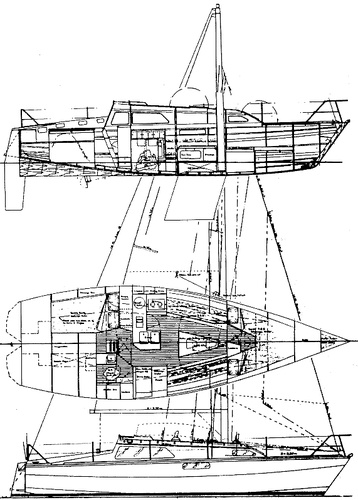CW 975 by Dudley Dix
Multi-chine plywood sloop
| Length overall | ||
|---|---|---|
| Waterline length | ||
| Beam | ||
| Draft | ||
| Berths | 6 | |
| Ballast weight | ||
| Displacement | ||
| Sail area | ||
| Engine power | 10 - 20 (inboard) | |
| Hull construction | Plywood | |
| See also | Didi 34, Coquette 39 | |
| compare | ||
URL: http://www.dixdesign.com/cw975.htm
Description:
A performance concept for the owner builder
- Award winning design
- Multi-chine plywood
- Easily serviced outboard rudder
- Fractional rig
- Easily driven fast cruiser racer
- Coastal or tradewind cruiser with exceptional offwind speed
- Inboard or transom hung rudder options
This design was drawn with a prime consideration being ease of construction by amateur builders, particularly those attempting a first boat. It was judged by an expert panel to be the winning design in the 1979 Design Competition run by Cruising World Magazine of Newport, USA.
The hull is of epoxy coated plywood multi-chine construction with longitudinal chine logs and stringers over transverse frames and bulkheads. The hull form has three chines each side with a flat central panel (no Vee on centreline) to eliminate structural joins in the skin in the keel area. The first chine has a sharp angle in the bow area to minimise pounding when heeled and twists to a flat angle aft for downwind performance.
The interior arrangement is a good workable layout for sea or port. It gives an easily worked galley and four good sea berths by the use of a full length leecloth dividing the double quarter berth into two singles in bad weather. The sail stowage area was placed forward of the forecabin to move the accommodation aft into a slightly more usable part of the boat. The stowage bin outboard of the double berth is there primarily to make the berth more comfortable when heeled, with stowage a secondary factor.
The galley, head and navigation areas have all been positioned to be in areas of relatively low movement in the boat. The circular bowl in the galley worktop provides secure stowage for loose items when sailing, is useful when preparing meals and lifts out to give access to a shelf in the locker below.
The engine is located in the central galley locker under the sinks where it has excellent all round access for maintenance. It is slighltly off centre to port, allowing the shaft to run alongside the skeg.
The ballast keel is a steel plate casing bolted through floors to the hull. An option added later for stronger wind areas is ballasted wings on the bottom of the keel. One is also being built with the delta bulb keel of the Didi 34. Other modifications are a 10% larger sail plan on the same mast height and a sugar scoop to the stern, taking her up to 33ft LOA.
The moderate displacement of this boat and her flat sections give her excellent downwind performance and her fine bow and efficient sail plan make her fast upwind. Although designed primarily as a fast coastal cruiser, she can be used for long distance cruising with a small crew. For a larger boat of similar concept, see the Coquette 39.
I built one of these boats for myself and sailed her for 7 years under the name "Concept Won". She proved to be fast all round, and exceptionally fast and easy to control downwind, achieving 18 knots on many occasions. I sold her while building my DIDI 38 "Black Cat".
See also
Boats about same size as CW 975

|
Trailer Sailer 32
Sailing Cruiser
|
|
Sharpie 36
Sailing Cruiser
|
Questions? Suggestions? Contact us at: info@boatplans.cc

